Part 47: March 23 Broadcast

You are listening to BBC radio 4. In an hour, we will be talking about Good Friday, and how religious reform in England has changed how we celebrate. For the next hour, Professor David Stephenson will be presenting a documentary on the second 80 years war of the eighteenth century. This series will be running every third day, up to 50 episodes. If you want news of the current war in the Middle East please channel in to BBC radio 1.
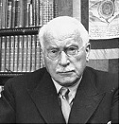 Good evening, and welcome to BBC radio 4. I’m Professor David Stephenson, professor of Dutch historical studies at Cambridge. This is the forty seventh part of our 50 episode special on the second 80 years war over Europe. Joining me for these broadcasts are fellow researchers and scholars Doctor Albert Andrews, specialist in German studies from the Berlin academy, Professor Robert Lowe, specialist in French studies at Cambridge, and a graduate student and technical assistant, Anton Thatcher. Last episode, we discussed eight long years of British rebellion.
Good evening, and welcome to BBC radio 4. I’m Professor David Stephenson, professor of Dutch historical studies at Cambridge. This is the forty seventh part of our 50 episode special on the second 80 years war over Europe. Joining me for these broadcasts are fellow researchers and scholars Doctor Albert Andrews, specialist in German studies from the Berlin academy, Professor Robert Lowe, specialist in French studies at Cambridge, and a graduate student and technical assistant, Anton Thatcher. Last episode, we discussed eight long years of British rebellion. During that same period, Poland had continued their crusade against the Dutch, but had given up on the notion of a full scale assault through the Dutch lines into Western Europe. From a new military port in Gdansk and the captured port around East Prussia, the Polish were attempting to create a new fleet to contest the Baltic Sea. To counter, the Dutch Baltic fleet was trying to keep the Polish ports in a state of constant repair to prevent the construction of ships, but they were not able to sufficiently ruin them to prevent the Polish from creating a fleet.
During that same period, Poland had continued their crusade against the Dutch, but had given up on the notion of a full scale assault through the Dutch lines into Western Europe. From a new military port in Gdansk and the captured port around East Prussia, the Polish were attempting to create a new fleet to contest the Baltic Sea. To counter, the Dutch Baltic fleet was trying to keep the Polish ports in a state of constant repair to prevent the construction of ships, but they were not able to sufficiently ruin them to prevent the Polish from creating a fleet.
The Dutch navy moves to keep the Polish out of the sea.
 The Polish were also moving their forces away from the Dutch portion of the line, attacking the Ottomans in the South. While they did not capture the Hungarian capital, they did manage to break past the Ottoman lines to wreak havoc in the undefended industry of the region.
The Polish were also moving their forces away from the Dutch portion of the line, attacking the Ottomans in the South. While they did not capture the Hungarian capital, they did manage to break past the Ottoman lines to wreak havoc in the undefended industry of the region.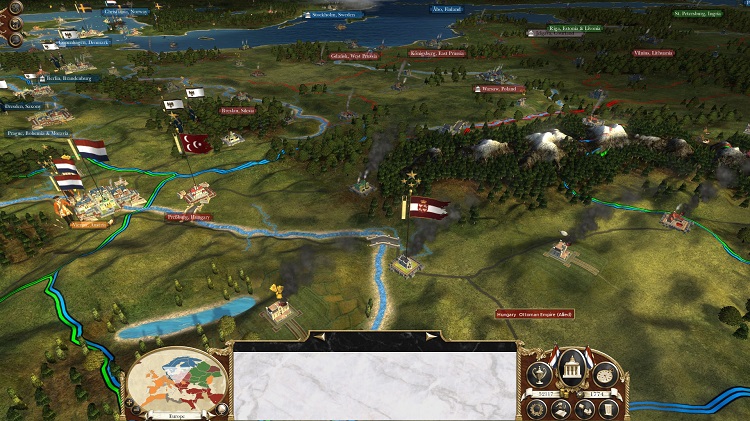
The Polish forces manage to break past the Ottoman lines, and while unable to capture the capital and secure the region of Hungary from the Ottomans, they were capable of causing terrible economic advantage while menacing the Ottoman flanks.
 And the Ottomans were showing a degree of weakness that hadn’t been evident before. Not only could they not control their front, but internal problems around Mesopotamia led to a rebel province under Mameluke military rule emerged as a separate state. Too tied up fighting the Polish along their far western front to react, they had to simply allow their independence, and at any rate, the Mameluke kingdom had petitioned to join the Federation as a separate entity from the Ottomans, a proposal the Dutch allowed after consulting with the Ottomans.
And the Ottomans were showing a degree of weakness that hadn’t been evident before. Not only could they not control their front, but internal problems around Mesopotamia led to a rebel province under Mameluke military rule emerged as a separate state. Too tied up fighting the Polish along their far western front to react, they had to simply allow their independence, and at any rate, the Mameluke kingdom had petitioned to join the Federation as a separate entity from the Ottomans, a proposal the Dutch allowed after consulting with the Ottomans.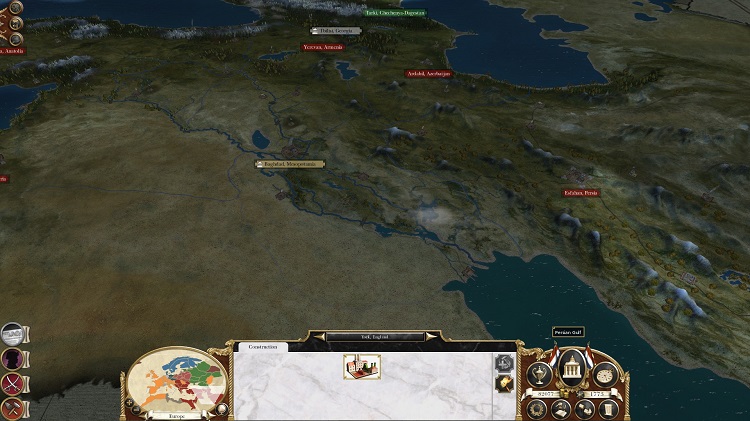
The Mamelukes form their own nation independent from Ottoman Rule. Tied up in the West, the Ottomans simple allow the cessation.
 Even so, success in the South did not grant the Polish the strength they would need. Prussia was recovering rapidly, and the Dutch were soon able to recall their troops from the Eastern front, leaving the buffer zone to the Prussians. The only garrison that remained behind was Strijder around Prague, as their withdrawal would leave Vienna too exposed from the North.
Even so, success in the South did not grant the Polish the strength they would need. Prussia was recovering rapidly, and the Dutch were soon able to recall their troops from the Eastern front, leaving the buffer zone to the Prussians. The only garrison that remained behind was Strijder around Prague, as their withdrawal would leave Vienna too exposed from the North.
The Prussians with Dutch financing have come back to strength, and began to actively oppose the Polish forces without direct Dutch reinforcements and garrisons. Dutch troops were withdrawn from the front, leaving it to the Prussians.
 The Dutch contribution to the actual conflict would occur primarily at sea. If the Polish managed to get their sea routes cleared, an invasion around to the coast of the Dutch Empire would potentially cause horrific damage, but in reality, it was only ignorance that would have brought the Polish to that conclusion. The Dutch, withdrawing their troops from the front now had an army of tens of thousands of men well stationed around Western Europe, but Polish intelligence was not capable of accurately distinguishing between each army group, making an accurate account from the many and disparate reports tricky to put into a cohesive picture.
The Dutch contribution to the actual conflict would occur primarily at sea. If the Polish managed to get their sea routes cleared, an invasion around to the coast of the Dutch Empire would potentially cause horrific damage, but in reality, it was only ignorance that would have brought the Polish to that conclusion. The Dutch, withdrawing their troops from the front now had an army of tens of thousands of men well stationed around Western Europe, but Polish intelligence was not capable of accurately distinguishing between each army group, making an accurate account from the many and disparate reports tricky to put into a cohesive picture.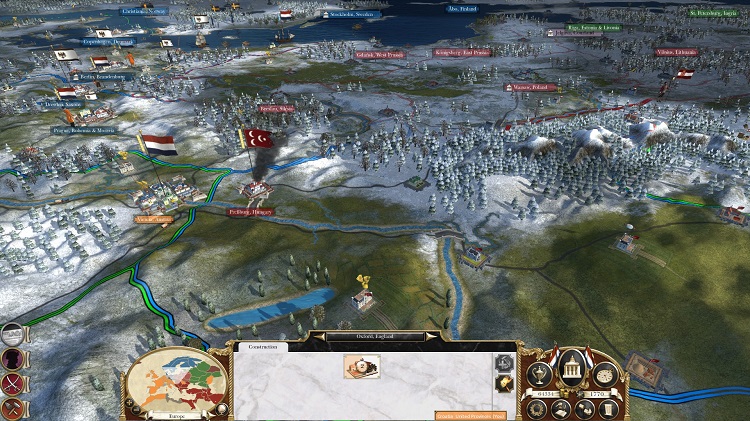
The furthest extent of Polish surety of Dutch military strength, as well as of her allies. Beyond here, the Polish were uncertain as to the military forces of their enemies.
 The Polish, despite constant raids to their military ports still managed to put together a relatively formidable navy. Two second rate ships of the line would lead their fleet, backed by several frigates managed to hunt down the diminutive Prussian navy, taking some damage before turning to repair at Gdansk.
The Polish, despite constant raids to their military ports still managed to put together a relatively formidable navy. Two second rate ships of the line would lead their fleet, backed by several frigates managed to hunt down the diminutive Prussian navy, taking some damage before turning to repair at Gdansk.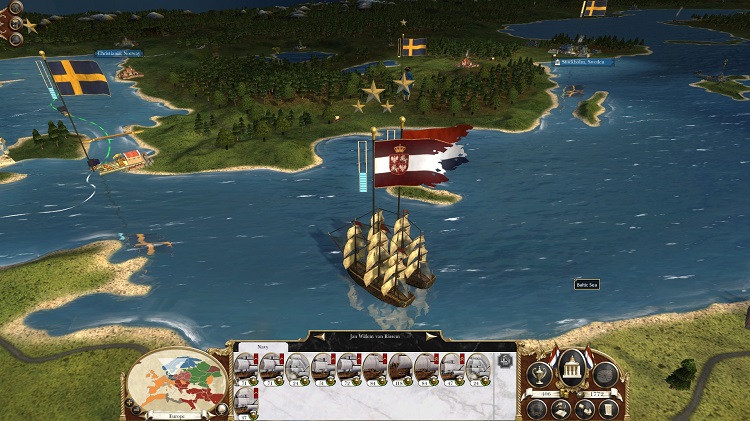
The Dutch navy blocks the Polish navy from making a return to port.
 The Dutch fleet however, managed to intercept them on their way back to port. The Dutch were running primarily third rate ships of the line, but also had a powerful heavy first rate, the Agatha. The Agatha was the heaviest ship in the world, with one hundred and twenty two cannon as well as various other guns such as carronades and heavy muskets, the Dutch ships was more than enough to defeat a second rate.
The Dutch fleet however, managed to intercept them on their way back to port. The Dutch were running primarily third rate ships of the line, but also had a powerful heavy first rate, the Agatha. The Agatha was the heaviest ship in the world, with one hundred and twenty two cannon as well as various other guns such as carronades and heavy muskets, the Dutch ships was more than enough to defeat a second rate.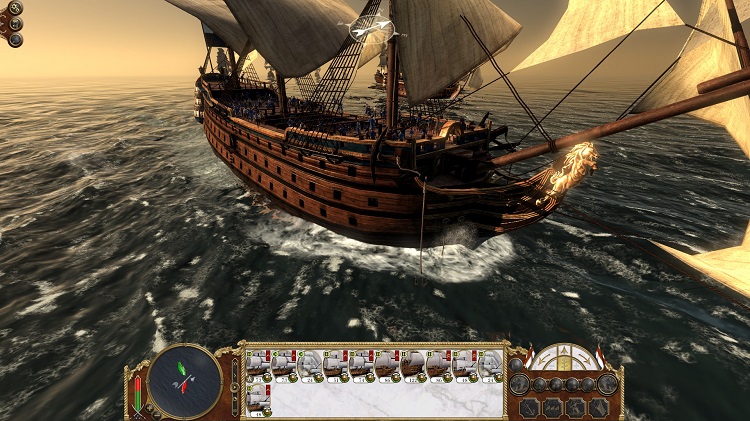
The Agatha, the largest war ship in the world at the time.
 The Dutch advanced in what had become their traditional naval formation, of heavy ships on one line, and the light ships supporting from another. The Polish fleet was advancing into the wind, using it to return to port, and so the Dutch were trying to blockade them with the wind from their fore, making it a slow battle for the Dutch as they struggled to come to the front line.
The Dutch advanced in what had become their traditional naval formation, of heavy ships on one line, and the light ships supporting from another. The Polish fleet was advancing into the wind, using it to return to port, and so the Dutch were trying to blockade them with the wind from their fore, making it a slow battle for the Dutch as they struggled to come to the front line.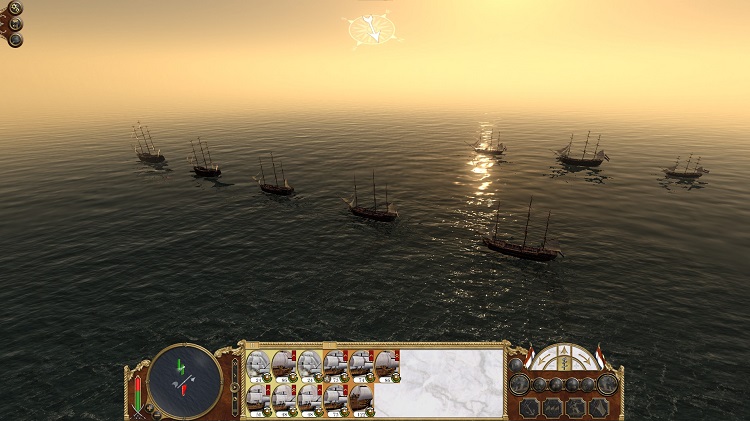
The Dutch naval formation of the age. The heavy ships would smash into the enemy fleet directly while the line of lighter ships would circle from a distance.
 Still, the Polish fleet trying to break directly past the Dutch granted the Dutch the first shots of the battle. The Agatha raked the front of the already battered lead ship, knocking it out of the battle in two short volleys. With their lead ship surrendered and stalled, the remaining line of Polish ships were forced into a crawl as their piled up ships tried to maneuver around.
Still, the Polish fleet trying to break directly past the Dutch granted the Dutch the first shots of the battle. The Agatha raked the front of the already battered lead ship, knocking it out of the battle in two short volleys. With their lead ship surrendered and stalled, the remaining line of Polish ships were forced into a crawl as their piled up ships tried to maneuver around.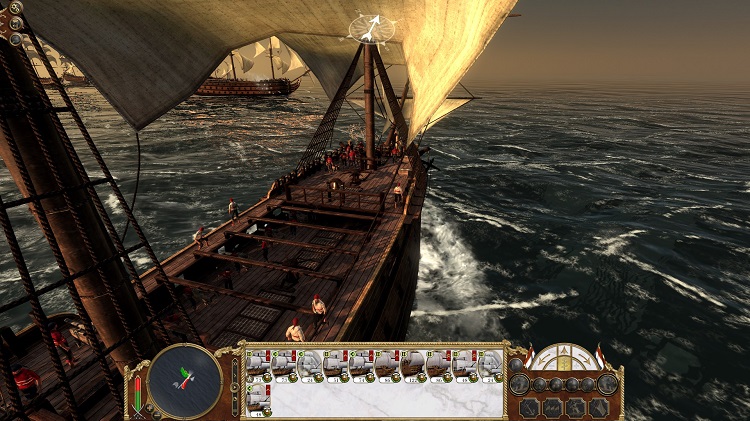
The lead Polish ship takes the first shots from the Dutch fleet. The Agatha would manage to work her way across the T, and another point blank folley would forestall the remaining Polish fleet.
 The pile up of ships granted the Dutch plenty of time to get directly in among the Polish ships into a close quarters battering match. The Dutch were at a definite advantage in this sort of combat with the heavy first rate and third rate ships doing more than their share of damage to the Polish ships. With only a second rate remaining capable of standing up to the Dutch ships of the line, the Polish return fire was fairly weak and limited, doing little damage to the Dutch vessels.
The pile up of ships granted the Dutch plenty of time to get directly in among the Polish ships into a close quarters battering match. The Dutch were at a definite advantage in this sort of combat with the heavy first rate and third rate ships doing more than their share of damage to the Polish ships. With only a second rate remaining capable of standing up to the Dutch ships of the line, the Polish return fire was fairly weak and limited, doing little damage to the Dutch vessels.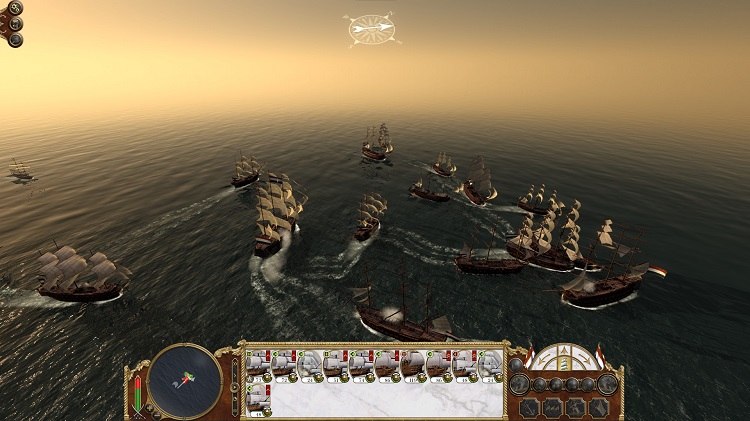
The Dutch fleet, being the heavier, more direct fleet was favoured in chaotic close in battles such as these.
 The Polish fleet, surrounded by so many cannons were quickly surrendering, but with so much fire power directed to the Polish second rate, a fifth rate managed to break past the Dutch lines. Badly battered, and with much of her crew dead, the ship made it past the heavier Dutch ships, but had lost most of their guns. Carronade frigates moved to pursue, and after a short period of chase, it became obvious that the small ships would catch up to the Polish ship. Rather than allow their ship to be captured, a member of the crew went down to the powder hold to blow it apart. Likely a religiously fanatical man, the explosion was timed to detonate as the Dutch frigate closed, but fortunately for the Dutch, the flaming wreckage did not catch on their sails.
The Polish fleet, surrounded by so many cannons were quickly surrendering, but with so much fire power directed to the Polish second rate, a fifth rate managed to break past the Dutch lines. Badly battered, and with much of her crew dead, the ship made it past the heavier Dutch ships, but had lost most of their guns. Carronade frigates moved to pursue, and after a short period of chase, it became obvious that the small ships would catch up to the Polish ship. Rather than allow their ship to be captured, a member of the crew went down to the powder hold to blow it apart. Likely a religiously fanatical man, the explosion was timed to detonate as the Dutch frigate closed, but fortunately for the Dutch, the flaming wreckage did not catch on their sails.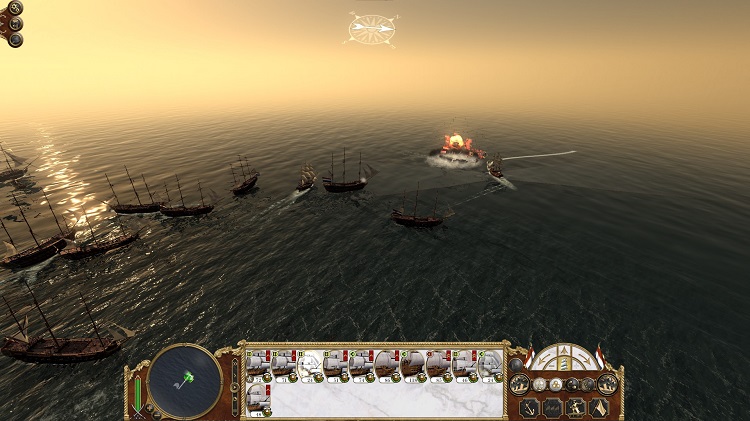
A Polish frigate is destroyed in a fiery explosion as a Dutch frigate approaches to capture her. The Dutch were extremely fortunate in that the damage they received from the blast was largely superficial, and the concussed crew had the many doctors of their larger ships to tend to them.
 Dutch command over the Baltic came slightly into question as the fleet was forced to sail all the way round to Rotterdam for repairs. While the Dutch did place a fleet led by the Eerste Edelle into the Baltic to replace their first fleet, this new fleet was far weaker. This fleet was also reliant on the third rate ships of the line, but did not have any first rate ships, meaning two second rates would be more than a match for the fleet’s ships of the line. On the other hand, the Eerste Edelle had been joined by three more steam powered ships, meaning if the Dutch were forced to sail into the wind to intercept the Polish fleet once more, they would be more agile.
Dutch command over the Baltic came slightly into question as the fleet was forced to sail all the way round to Rotterdam for repairs. While the Dutch did place a fleet led by the Eerste Edelle into the Baltic to replace their first fleet, this new fleet was far weaker. This fleet was also reliant on the third rate ships of the line, but did not have any first rate ships, meaning two second rates would be more than a match for the fleet’s ships of the line. On the other hand, the Eerste Edelle had been joined by three more steam powered ships, meaning if the Dutch were forced to sail into the wind to intercept the Polish fleet once more, they would be more agile.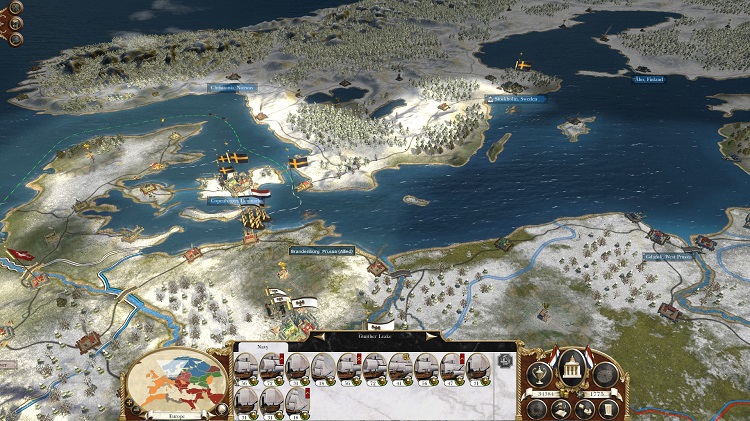
A Dutch replacement fleet moves in to replace the former Baltic fleet.
 And this trait would come in useful. The Polish did indeed manage to create another fleet, this time of two second rates, a third rate and a pair of frigates. Again, a powerful fleet, the Dutch would have a far harder time in defeating this force. Pushing into the wind, the Dutch steam ships would do far more and far more dangerous work than was their due. With only twenty four guns per ship, their combined broadside was only marginally greater than a single second rate ship of the line.
And this trait would come in useful. The Polish did indeed manage to create another fleet, this time of two second rates, a third rate and a pair of frigates. Again, a powerful fleet, the Dutch would have a far harder time in defeating this force. Pushing into the wind, the Dutch steam ships would do far more and far more dangerous work than was their due. With only twenty four guns per ship, their combined broadside was only marginally greater than a single second rate ship of the line.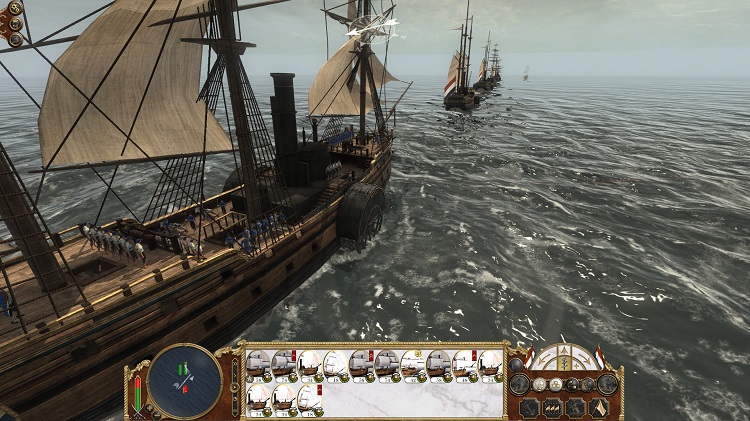
The Dutch steam ships arranged in line. Forced into the wind once more, the steam powered ships allowed faster response than was previously possible.
 Still, the Dutch fleet advancing rapidly into the wind put the Polish fleet on edge. Their advance was slowed as some of their ships turned back, only moving back to the fore upon the observation that the swift Dutch ships were heavily under gunned. Moving from a pair of parallel lines, the Polish moved into a single line to exchange shots with the Dutch. Unlike in the previous battle, the Polish fleet had the advantage in a direct fire fight.
Still, the Dutch fleet advancing rapidly into the wind put the Polish fleet on edge. Their advance was slowed as some of their ships turned back, only moving back to the fore upon the observation that the swift Dutch ships were heavily under gunned. Moving from a pair of parallel lines, the Polish moved into a single line to exchange shots with the Dutch. Unlike in the previous battle, the Polish fleet had the advantage in a direct fire fight.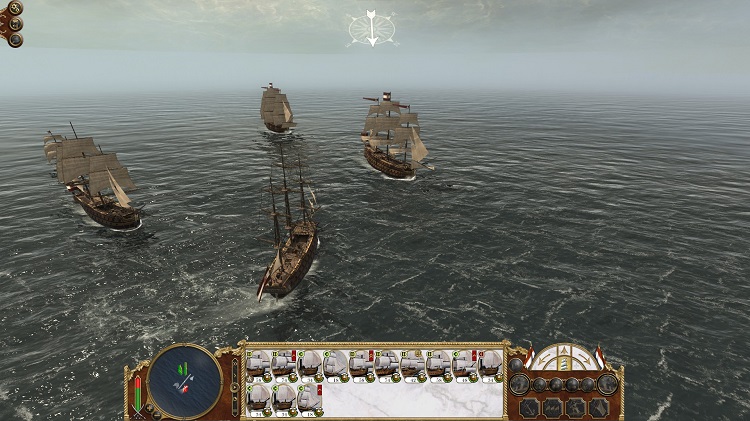
The Polish fleet in disarray upon seeing the Dutch fleet advancing quickly into the wind, but the Polish captains managed to get their crew back in order after a short while.
 The Dutch and Polish ships of the line managed their shots at approximately the same time, both sides willing to fight directly. The Dutch third rates were obviously taking the worst of it, as the far heavier pair of second rates came ahead of the first and second exchanges, causing terrible damage to the Dutch thirds.
The Dutch and Polish ships of the line managed their shots at approximately the same time, both sides willing to fight directly. The Dutch third rates were obviously taking the worst of it, as the far heavier pair of second rates came ahead of the first and second exchanges, causing terrible damage to the Dutch thirds.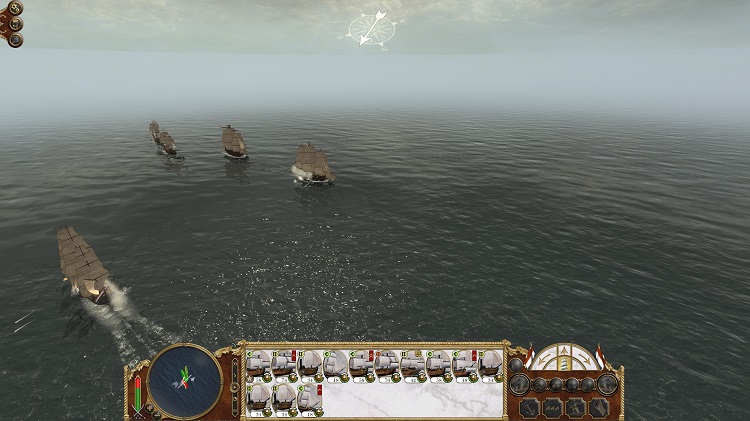
Opening shots of the battle.
 Still, the second rates had far more ships to pass, and even though the Dutch lead third had begun taking on water, the Polish ships were being worn down. The agile steam powered ships had crossed in front of the Polish fleet, stalling them once more and firing their shots into the bow. With only a few cannon however, the damage was fairly minimal to the sturdy Polish ship.
Still, the second rates had far more ships to pass, and even though the Dutch lead third had begun taking on water, the Polish ships were being worn down. The agile steam powered ships had crossed in front of the Polish fleet, stalling them once more and firing their shots into the bow. With only a few cannon however, the damage was fairly minimal to the sturdy Polish ship. 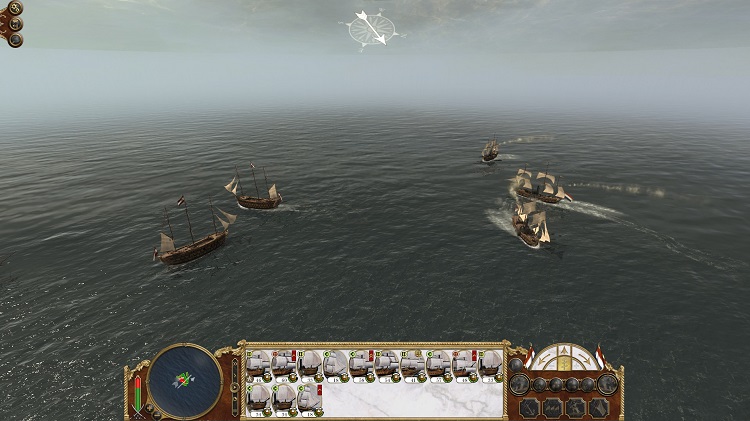
Dutch steam ships, in defiance of nature fire their shots directly into the fore of the Polish second rate. While the most effective shots that they could manage, the limited number of guns made certain that the Polish would remain in the fight for a while longer.
 As the battle wore on, the Polish managed to draw some blood against the Dutch fleet, blowing apart their sloop with a lucky hit on their powder stores, and the Dutch lead third was listing heavily to her side, clearly about to sink. A Dutch fifth was also sporadically taking on water, but seemed to have their pumps and repairs under control.
As the battle wore on, the Polish managed to draw some blood against the Dutch fleet, blowing apart their sloop with a lucky hit on their powder stores, and the Dutch lead third was listing heavily to her side, clearly about to sink. A Dutch fifth was also sporadically taking on water, but seemed to have their pumps and repairs under control. 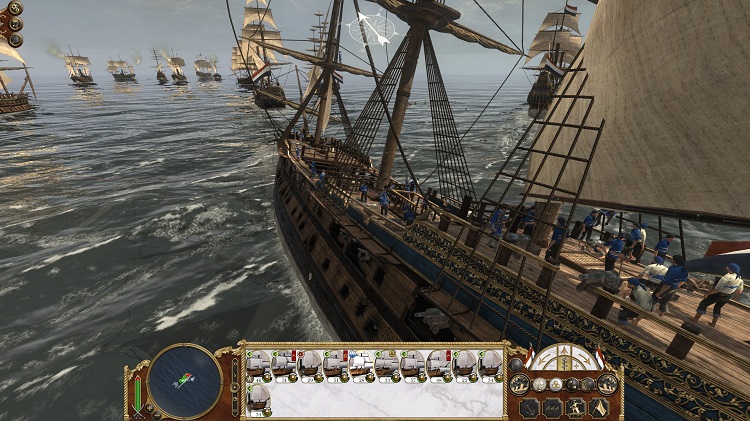
A Dutch third rate tilts heavily to her side. In the frigid winter waters of the Baltic, the crew died well before they could be recovered, even though the battle would only last a few minutes longer.
 Still, the Dutch passes had nearly completely exposed the innards of the Polish vessels which were only afloat due to a bit of luck, as every shot had merely decimated their crew rather than hitting below the water line. The second rates, formerly with far more guns and a thicker hull, were finding themselves evenly matched against Dutch steam ships that came along their sides in terms of both cannons to fire and strength of hull to resist those shots.
Still, the Dutch passes had nearly completely exposed the innards of the Polish vessels which were only afloat due to a bit of luck, as every shot had merely decimated their crew rather than hitting below the water line. The second rates, formerly with far more guns and a thicker hull, were finding themselves evenly matched against Dutch steam ships that came along their sides in terms of both cannons to fire and strength of hull to resist those shots.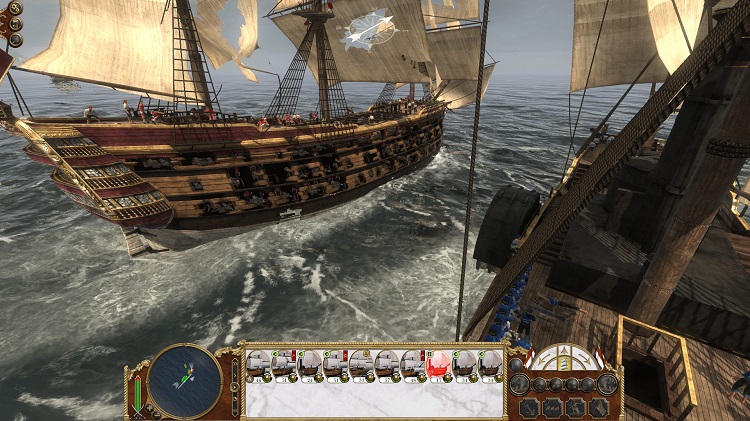
Late into the battle, the Polish ships were so worn down that the Dutch steam ships could go broadside to broadside against them.
 As the Polish support vessels had eventually retreated, and with the Dutch navy closing in around the battered ships, the Dutch opted to board the few remaining ships. A few feeble volleys of crippled cannon fire tried to fend off the swift Dutch ships, but the Dutch managed to get their hooks into the second rates, the crew that jumped aboard finding the Polish crew mostly dead, and found the few remaining unwilling to continue the fight. The Dutch fleet had lost a third rate and a sloop, but had captured two second rate ships in return.
As the Polish support vessels had eventually retreated, and with the Dutch navy closing in around the battered ships, the Dutch opted to board the few remaining ships. A few feeble volleys of crippled cannon fire tried to fend off the swift Dutch ships, but the Dutch managed to get their hooks into the second rates, the crew that jumped aboard finding the Polish crew mostly dead, and found the few remaining unwilling to continue the fight. The Dutch fleet had lost a third rate and a sloop, but had captured two second rate ships in return.
The Eerste Edelle captures a second rate ships of the line.
 The Dutch knew that these attacks would continue in some capacity. The Eerste Edelle and her fleet would have to return to Rotterdam for repair, meaning their ships could not be used to control the Polish ports. While the Agatha would be free to return next season, it would not make it to East Prussia in time to stop the creation of new vessels, meaning another naval battle against the Polish crusaders was incredibly likely.
The Dutch knew that these attacks would continue in some capacity. The Eerste Edelle and her fleet would have to return to Rotterdam for repair, meaning their ships could not be used to control the Polish ports. While the Agatha would be free to return next season, it would not make it to East Prussia in time to stop the creation of new vessels, meaning another naval battle against the Polish crusaders was incredibly likely.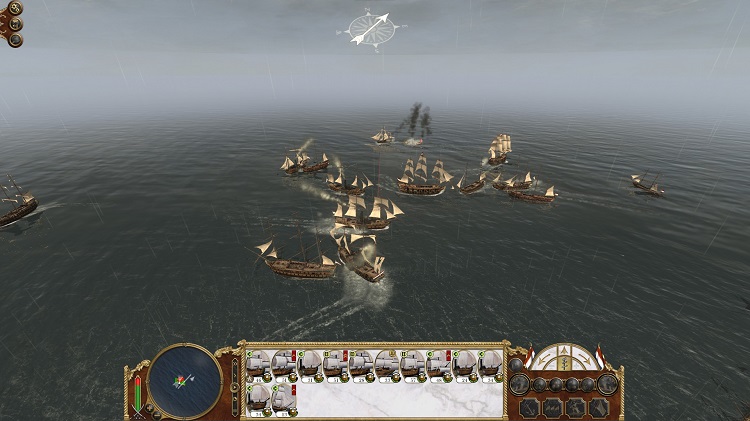
The Dutch and Polish fleets had engaged in a much less one sided, but no less brutal fight, leaving many dead on both sides.
 Still, with the reconstituted Prussian forces on the field, the Polish army lost Gdansk, and along with it, their military port, leaving them with just the military port in East Prussia. The Prussian army had been revitalized mostly by the injection of millions in loans from the Dutch, letting the Dutch preserve their citizens from the losses of war over a territory that was not their own, and of which they had little interest. With Britain in hand, the East no longer required the security it had needed ages ago, and so the Dutch had begun to settle into a state of armed vigilance in their inner territories.
Still, with the reconstituted Prussian forces on the field, the Polish army lost Gdansk, and along with it, their military port, leaving them with just the military port in East Prussia. The Prussian army had been revitalized mostly by the injection of millions in loans from the Dutch, letting the Dutch preserve their citizens from the losses of war over a territory that was not their own, and of which they had little interest. With Britain in hand, the East no longer required the security it had needed ages ago, and so the Dutch had begun to settle into a state of armed vigilance in their inner territories.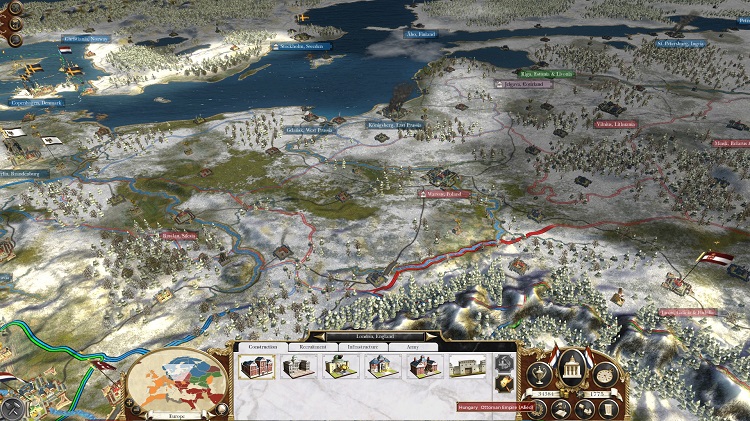
The Prussians make an advance through the Polish state.
 The only exposed territory was Romania, cut off from the rest of the Dutch empire. The Dutch had still managed to move their army through allied territory, though at the cost of twenty million guilders, and so Romania was by no means poorly garrisoned. They had developed a fortress around Transylvania, and their forces were well prepared to defend it to the last, but at the same time, Transylvania held little strategic value to the Dutch. Their main reason for maintaining the garrison was in their desire to maintain a presence which could directly strike at the Polish forces without having to cross through the buffer zone, which would slow mobilization far too much for their liking.
The only exposed territory was Romania, cut off from the rest of the Dutch empire. The Dutch had still managed to move their army through allied territory, though at the cost of twenty million guilders, and so Romania was by no means poorly garrisoned. They had developed a fortress around Transylvania, and their forces were well prepared to defend it to the last, but at the same time, Transylvania held little strategic value to the Dutch. Their main reason for maintaining the garrison was in their desire to maintain a presence which could directly strike at the Polish forces without having to cross through the buffer zone, which would slow mobilization far too much for their liking.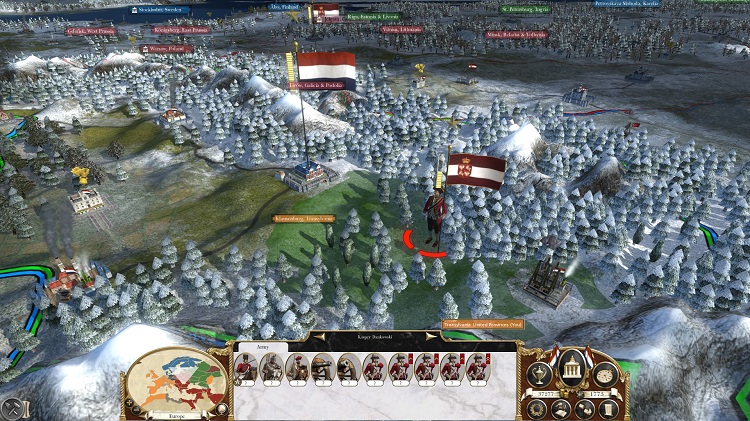
The remote Dutch outpost stands vigilant against the Polish crusaders.
 This exposed station came under fire from the Polish forces first however, as a Polish force attempted to pass through the Carpathian Mountains. A powerful raid, hoping to break through the Dutch lines at Transylvania to reinforce their breakthrough in Hungary had crossed the mountains in the hopes that the Dutch would not have the means to defend themselves in such a remote land, but the Dutch would have none of that. The Dutch moved to counter attack as soon as the Polish army made it across the mountains, hoping to prevent them from fleeing by putting their backs to the mountainside.
This exposed station came under fire from the Polish forces first however, as a Polish force attempted to pass through the Carpathian Mountains. A powerful raid, hoping to break through the Dutch lines at Transylvania to reinforce their breakthrough in Hungary had crossed the mountains in the hopes that the Dutch would not have the means to defend themselves in such a remote land, but the Dutch would have none of that. The Dutch moved to counter attack as soon as the Polish army made it across the mountains, hoping to prevent them from fleeing by putting their backs to the mountainside.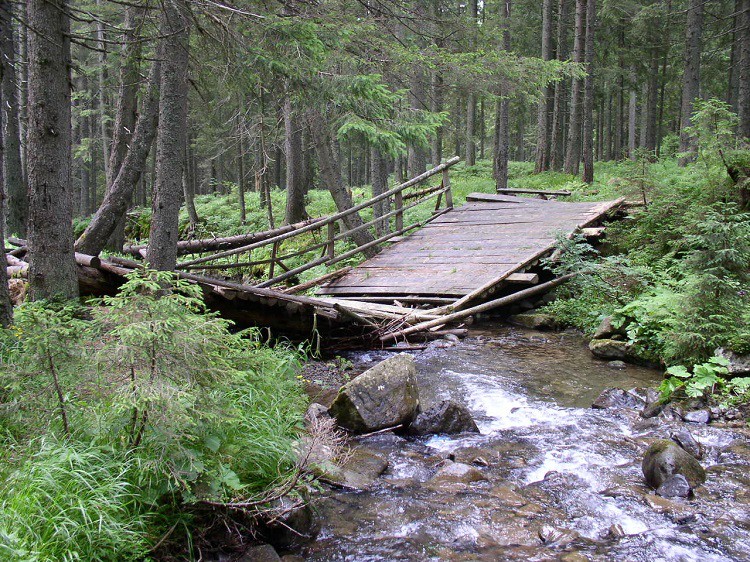
An old broken bridge from the era. While rebuilt several times, it was originally created to allow artillery past the shallow mountain river.
 Next, we will be talking about good Friday as celebrated in the British isles followed by world news. If you want news of the current war in the Middle East please channel in to BBC radio 1. David Stephenson will be presenting more on the 80 years war in 3 days.
Next, we will be talking about good Friday as celebrated in the British isles followed by world news. If you want news of the current war in the Middle East please channel in to BBC radio 1. David Stephenson will be presenting more on the 80 years war in 3 days.